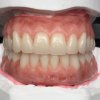Incisal guidance is a function of Hanau's quint. Failure to achieve balance means the other elements of the quint weren't addressed.
For the curious, these elements would be:
incisal guidance, condylar guidance, cusp height, plane of occlusion, and compensating curve.
Christensen's phenomenon describes how a gap occurs between the posterior occlusal contacts because of translation of the mandible downward and forward in protrusive. In complete denture construction balance is introduced by building in compensating curves utilizing the appropriate cusp height for the occlusal scheme.








